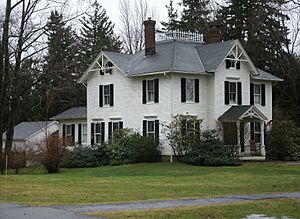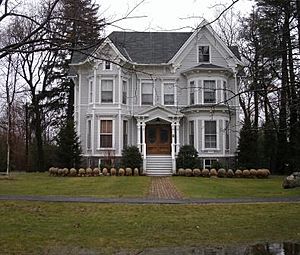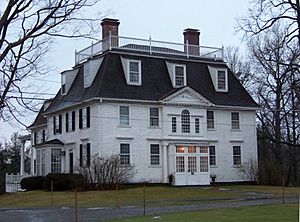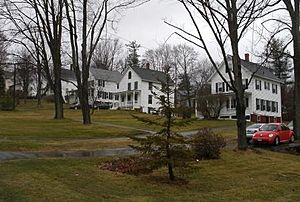Litchfield Historic District facts for kids
|
Litchfield Historic District
|
|
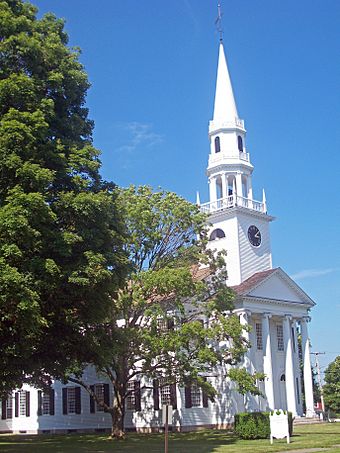
South elevation and west profile of First Congregational Church, 2010
|
|
| Location | Litchfield, CT |
|---|---|
| Architect | William Sprat |
| Architectural style | Georgian, Greek Revival, Late Victorian |
| NRHP reference No. | 68000050 (original) 78003456 (increase) |
Quick facts for kids Significant dates |
|
| Added to NRHP | November 24, 1968 |
| Boundary increase | November 29, 1978 |
| Designated NHLD | November 24, 1968 |
The Litchfield Historic District in Litchfield, Connecticut is a very special place. It was named a National Historic Landmark in 1968. This means it's a great example of a late 1700s New England village that has been kept very well. Being a National Historic Landmark also means it's on the National Register of Historic Places.
This important area is part of an even bigger historic district. That larger area covers all of Litchfield. This larger historic area became a state historic district in 1959. The main building in this historic neighborhood is the Litchfield meetinghouse, built in 1829. Many buildings here show the Georgian architecture style. They often have wooden siding, pointed roofs, and sometimes sloped roofs.
Contents
Exploring the Litchfield Town Green
The heart of the Litchfield Historic District is the Litchfield Town Green. You can find it where U.S. Route 202 and Route 63 meet. These are the main roads through the town of Litchfield.
History of the Green
The village green was first created in 1720. Back then, it was mostly used as a place for animals to graze. The very first town meetinghouse was built here in 1723. Over the years, other important buildings were added. The first schoolhouse in the area was built on the green in 1732. The county courthouse followed in 1751. This happened when Litchfield became the main town for the new Litchfield County.
From Pasture to Park
After the Revolutionary War, the green was no longer used for grazing animals. Instead, it became a place for military parades. In 1836, the town officially made it a park. During the Civil War, the green was a center for recruiting soldiers. It was also where returning soldiers were welcomed home. In the 1900s, many trees and bushes were planted. Benches were added for people to relax. You can also find several war monuments and a memorial fountain there today.
Discovering South Street Homes
Many historic houses line South Street in the district. One very important building here is the Tapping Reeve House and Law School. It is also known as the Litchfield Law School. This was a one-room schoolhouse. It was actually the first law school in the United States! Famous people like Aaron Burr and John C. Calhoun studied law here.
North Street's Historic Sheldon Tavern
On North Street, you'll find the Sheldon Tavern. This building is an important part of the historic district. It used to be the home of Elisha Sheldon. He was a colonel during the Revolutionary War. The tavern was named after him.
East Street's Charming Houses
The district also includes many historic houses on East Street. These homes are built along a hill. They lead away from the main church and the downtown area.
Images for kids




